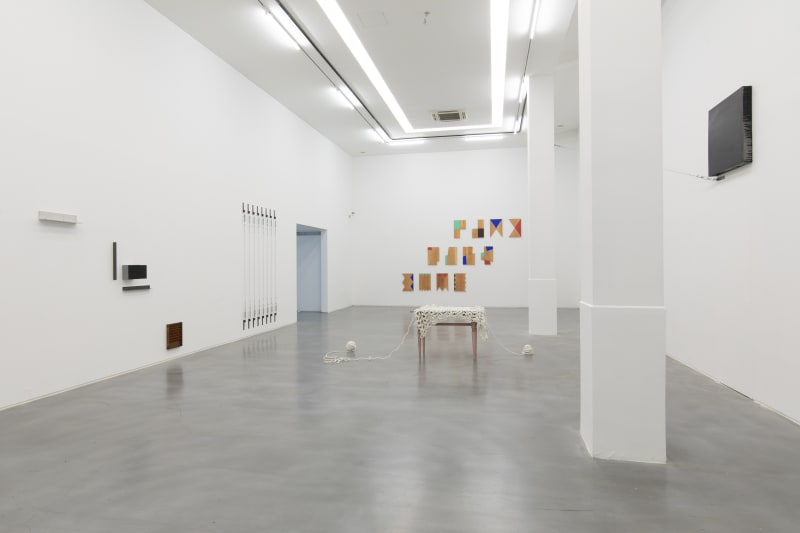Unveiling slowly, Wall and Wire Rope wrapped by clean muslin showing up, a sound of polyphony settled in the precise structure is unfolding tunefully and simultaneously with an aesthetic mode of energy and logic.
PolyChord is a dynamic curve generated by the representative artworks of Koshimizu Susumu and HARAGUCHI Noriyuki which reflects on each other while taking part in the space site. The essence of the structure of their works relates to the attributes of nature objects and industrial elements, as well as to the connection of particular positions. It is full of synergic rhythm of counterpoint and balance in the diversification and combination by decomposing and reorganizing. The concise repetition and accumulation develops evolvement and advancement to promote the strengthening of quality. In their creations, the similarities and differences, separation and unification, coordination and confrontation are visual representation of the nature world and social relations.
PolyChord, the exhibition of KOSHIMIZU Susumu and HARAGUCHI Noriyuki will open on May 30, 2020 at Asia Art Center (Shanghai). The exhibition will be on view until July 26, 2020.
About Artists
KOSHIMIZU Susumu was born in 1944 in Ehime Prefecture, Japan. He graduated from Sculpture Department, Tama Art University and later became one of the key members of Mono-ha, a group of artists who turned prominent in the late 1960s and 1970s. From early on, Koshimizu’s investigation of material and space resulted in some of Mono-ha’s most definitive artworks. Koshimizu’s installations and sculptures during the 1960s and 1970s focused on the qualities inherent to but not visible in an object. He shows concern for the materiality of objects—a desire to expose the fundamentals of sculpture, often revealed through juxtaposition. At the beginning of the 1970s, Koshimizu started to explore specifically the structure of surfaces.
The artist’s important exhibitions include Mono-ha, Fondazione Mudima (Milan, Italy, 2015); Parallel Views: Italian and Japanese Art from the 1950s, 60s, and 70s, The Warehouse, (Dallas, Texas, U.S.A., 2013); Century City Art and Culture in the Modern Metropolis, Tate Modern (London, UK, 2001); Matter and Perception: 1970 Mono-ha and the Search for Fundamentals, The Museum of Fine Arts, Gifu, Japan, from 17 Feb. to 26 March, 1995 (traveled to Hiroshima City Museum of Contemporary Art, from Aug. 19th to Sep. 24th; Kitakyushu Municipal Museum of Art, from Oct. 7 to Dec. 17 and The Museum of Modern Art, Saitama. In 1996, this exhibition traveled to Museum of Modern and Contemporary Art, Saint-Etienne, France. Japanese Art after 1945: Scream Against the Sky, Solomon R. Guggenheim Museum, New York (traveled to San Francisco Museum of Modern Art, San Francisco, U.S.A.) (1994); Avant-Garde Arts of Japan 1910-1970, Centre Pompidou, Paris, France (1986) ;17th Sao Paolo Biennale (Sao Paolo, Brazil, 1983); 37th & 39th Venice Biennale, Venice, Italy (1976 & 1980), and 7th Paris Youth Biennale (Paris, France, 1971).
HARAGUCHI Noriyuki was born in Yokosuka, Kanagawa, Japan, in 1946, and he graduated from the Department of Oil Painting at Nihon University, Tokyo, in 1970. He began exhibiting his works while in college, amidst the rising political turmoil of campus protests and student riots against the Vietnam War and the Japan-US Security Treaty. Coincidentally, Yokosuka was the home port of the US Navy’s Seventh Fleet, and Haraguchi’s early paintings and sculptures, such as the Ships series (1963–65), Tsumu 147 (Freight Car) (1966), and Air Pipes series (1968–69), referenced the aesthetics and materials of heavy industry. Haraguchi created the iconic sculpture A-4E Skyhawk (1968–69) behind the student barricades at Nihon University; it was a full-scale reproduction of the eponymous US Navy fighter jet and was exhibited at the university before riot police retook the campus. Subsequently, Haraguchi’s adopted materials have come to include I-beams, pressed-steel car parts, waste oil, polyurethane, and rubber—creating an aesthetic vocabulary quite distinct from his Mono-ha contemporaries such as Lee Ufan, Sekine Nobuo, and Suga Kishio, who embraced more natural materials.
Since the early 1970s, Haraguchi has exhibited extensively in Japan and abroad. In 1977, his spent-oil reflecting pool Matter and Mind was exhibited at Documenta 6 in Kassel, Germany, which received critical feedback; in the same year, he also participated in the 10th Biennale de Paris. In 1978, his first solo exhibition abroad was held at Galerie Alfred Schmela, Dusseldorf; in 2001, his retrospective exhibition was organized at Städtische Galerie im Lenbachhaus, Munich; in 2007, his works were included in the group exhibition “Das schwarze Quadrat – Hommage an Malewitsch” at Hamburger Kunsthalle, Hamburg, Germany. In recent years, Haraguchi’s major retrospective exhibition “Society and Matter” was organized at his hometown, BankART Studio NYK at Kanagawa, in 2009; in 2012, he exhibited alongside other influential Japanese modern artists, such as Sekine Nobuo, Kusama Yayoi and Shiraga Kazuo at the group exhibition “Tokyo 1955-1970: A New Avant-Garde” at MoMa, New York. The “Oil Pool” he created for Art Base Momoshima is one of his only two permanently exhibiting works, as well as being an iconic piece of Post-Mono-ha. Haraguchi’s works are collected by Meguro Museum of Art (Tokyo, Japan), Toyota Municipal Museum of Art (Aichi, Japan), Tate Modern (London, UK), Museum of Modern Art (New York, US), Tehran Museum of Contemporary Art (Tehran, Iran), Kröller-Müller Museum (Otterlo, Netherlands), Inhotim Museum (Brumadinho, Brazil) and Städtische Galerie im Lenbachhaus (Munich, Germany).

